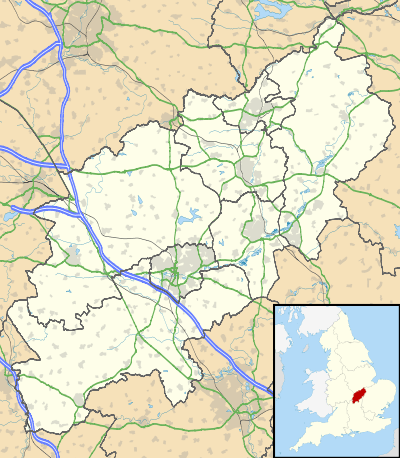Aynho
Aynho (/ˈeɪnhoʊ/, formerly spelt Aynhoe) is a village and civil parish in South Northamptonshire, England, on the edge of the Cherwell valley about 6 1⁄2 miles (10.5 km) southeast of the north Oxfordshire town of Banbury and 7 miles (11 km) southwest of Brackley.
| Aynho | |
|---|---|
 Aynho Location within Northamptonshire | |
| Population | 632 (2001 census[1]) 659 (2011 census.)[2] |
| OS grid reference | SP5133 |
| Civil parish |
|
| District | |
| Shire county | |
| Region | |
| Country | England |
| Sovereign state | United Kingdom |
| Post town | Banbury |
| Postcode district | OX17 |
| Dialling code | 01869 |
| Police | Northamptonshire |
| Fire | Northamptonshire |
| Ambulance | East Midlands |
| UK Parliament | |
Along with its neighbour Croughton 2 miles (3.2 km) to the east, it is one of the two southernmost villages in Northamptonshire.
It is the southernmost settlement in the entire English East Midlands region.
History
Aynho was founded in Anglo-Saxon times. The toponym is derived from Aienho, Old English for a spring, grove or hill. The circular village was surrounded by a defensive wall, parts of which can still be seen.
In the 11th century Asgar, a Saxon thegn and standard bearer to Edward the Confessor owned the manor of Aynho. After the Norman conquest of England he was forced to cede the manor to Geoffrey de Mandeville, whose family retained it for several generations. Later the manor passed through the Clavering, Neville, Fitzalan, Shakerley, Tracy and Marmion families. Late in the 16th century Aynhoe Park was sold to Richard Cartwright (born 1563, a barrister and member of the Inner Temple, from a Cheshire family) who moved to Aynho in 1616. It then remained in the Cartwright Family for over three hundred years.
Late in the 12th century Roger and Alice FitzRichard founded the Hospital of Saints James and John in Aynho to care for the poor, the sick and the infirm.[3] Their son Robert FitzRoger and subsequent benefactors increased the endowments of the hospital but in the 15th century it declined.[3] In 1483 the 16th Earl of Arundel granted the hospital's advowson and patronage to William Waynflete, Bishop of Winchester.[3] In 1458 Waynflete had founded Magdalen College, Oxford and in 1485 he granted the hospital to the college.[3] At some time thereafter the hospital seems to have become a private house.[3]
Notable buildings
The Church of England parish church of Saint Michael has a 14th-century Decorated Gothic tower.[4] The rest of the church was demolished in 1723 and rebuilt over the next two years in neoclassical style.[4] The interior retains its Georgian pulpit, box pews and west gallery.[4]
Several cottages in the village, some with exterior staircases, predate the Tudor period. A Tudor yeoman's house was turned into a free Grammar School founded in 1654 by John Cartwright, and later became the dower house of the Manor of Aynhoe Park on the southern edge of the village.[5]
Aynho almshouses were built in 1822.[6]
Transport history
The Oxford Canal was built through the western part of the parish in 1787.[7] Aynho Wharf, 1 mile (1.6 km) west of the village, is on the Aynho – Deddington road.
Construction of the Oxford and Rugby Railway between Oxford and Banbury began in 1845. By the time the line opened in 1850 the Great Western Railway had taken it over. Aynho for Deddington railway station was close to Aynho Wharf of the earlier constructed Oxford Canal on the Aynho to Deddington road, which thereafter became known as Station Road.
In 1910 the GWR completed the Bicester cut-off line, linking it with the Oxford and Rugby Railway at Aynho Junction, a new flying junction built in the parish. The company provided a second station, Aynho Park railway station, on the new line 130 yards (120 m) east of the existing station. British Railways closed Aynho Park in 1963 and Aynho for Deddington in 1964. Aynho Junction is now used by Chiltern Railways, CrossCountry, Great Western Railway and freight traffic.
The M40 motorway now runs close to the west of the village with the nearest access at junction 10, with the A43 trunk road about 3.5 miles (5.6 km) south.
Notable residents
Residents have included the 17th-century politician Sir Ralph Winwood, the 19th-century Irish-based judge Charles Burton, the 19th- and 20th-century architect Philip Speakman Webb and the 20th-century mathematician Mary Cartwright.[8]
Amenities
Aynho has a hotel and restaurant in the village, the Cartwright. About half a mile outside the village, there's a public house, the Great Western Arms, controlled by the Hook Norton Brewery.[9]
See also
- History of Banbury, Oxfordshire
References
- Office for National Statistics: Aynho CP: Parish headcounts, retrieved 25 November 2009
- "Civil Parish population 2011". Neighbourhood Statistics. Office for National Statistics. Retrieved 29 June 2016.
- Serjeantson & Adkins, 1906, pages 150–151
- Pevsner & Cherry, 1973, page 96
- Osborne, page not cited
- Pevsner & Cherry, 1973, page 99
- Compton, 1976, page 37
- "Mary Cartwright (1900–1998)". mathshistory.st-andrews.ac.uk. Retrieved 17 December 2019.
- Hook Norton Pubs: Great Western Arms Archived 9 February 2009 at the Wayback Machine
Further reading
- Compton, Hugh J. (1976). The Oxford Canal. Newton Abbot: David & Charles. p. 37. ISBN 0-7153-7238-6.
- Osborne, Edgar (ed.). Aynhoe Park: An Illustrated Survey of the Northamptonshire Home of the Cartwright Family. Derby: English Life Publications.
- Pevsner, Nikolaus; Cherry, Bridget (1973). The Buildings of England: Northamptonshire. Harmondsworth: Penguin Books. pp. 96–99. ISBN 0-14-071022-1.
- Serjeantson, R.M.; Adkins, W.R.D., eds. (1906). Victoria County History: A History of the County of Northampton, Volume 2. pp. 150–151.